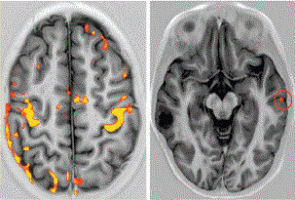
In efforts to improve the treatment of brain tumours, researchers in Italy are developing piezoelectric nanoparticles that target and electrically stimulate tumour cells upon exposure to ultrasound.
In this preliminary in vitro study, published in the Journal of Colloid and Interface Science, the researchers observed reduced proliferation and increased sensitivity to chemotherapy of the tumour cells using the nanoparticles, as well as the first transit of a piezoelectric material across a simulated blood–brain barrier.
The most common brain tumour in adults, glioblastoma multiforme has a poor prognosis, with an average survival of 14 months following diagnosis.
Drug resistance acquired during chemotherapy and disease recurrence through the spread of microscopic tumour foci are major factors limiting the success of treatment, which typically involves surgery followed by chemotherapy and/or radiotherapy.
As part of a treatment regime, electrical stimulation has the potential to overcome both issues.
Previous research has demonstrated that electrical stimulation reduces drug resistance by impeding P-glycoprotein, a protein that pumps damaging substances, including chemotherapy drugs, out of the tumour cells.
Low-intensity stimulation is also known to reduce cell proliferation, which the researchers previously demonstrated in breast cancer cells.
It does so by disrupting the regulation of extracellular levels of calcium and potassium ions and impairing cellular components instrumental in cell division.
Nanoparticles have two key advantages over stimulation approaches already used to treat diseases such as epilepsy.
“Traditional electric stimulation is either invasive, with electrodes penetrating the skull and brain parenchyma, or non-specific, with electrodes attached to the scalp,” says joint first author Attilio Marino, of IIT’s Smart Bio-interfaces group. “Our goal is to perform precision nanomedicine only on diseased cells.”
The targeting of tumour cells is desirable to avoid any adverse effects on healthy cells that are also disrupted by electrical stimulation.
To achieve this, the researchers functionalised their barium titanate nanoparticles by incorporating the anti-transferrin receptor antibody.
By seeking out transferrin receptors, which are overexpressed on the surface of several types of cancer cells including glioblastoma, the nanoparticles target the tumour over healthy tissue.
The antibody also promotes transport of the nanoparticles across the blood–brain barrier via transferrin receptors on the surface of the endothelial cells that form the barrier.
In their experiments, the researchers investigated the ability of the functionalised nanoparticles to cross the blood–brain barrier, mimicking it with a layer of brain-derived endothelial cells in a dish.
Another experiment investigated uptake of the nanoparticles into human glioblastoma cells.
These revealed significantly greater transport across the mimicked blood–brain barrier and increased uptake by the tumour cells than when using non-functionalised nanoparticles.
In further tests, tumour cell proliferation decreased markedly when the functionalised nanoparticles were combined with ultrasound, compared with a control of ultrasound alone.
When the chemotherapy drug temozolomide was added, the anti-proliferative effect increased further still, with 72.1±1.7% cell survival versus 100.0±7.2% in a control.
The combination also resulted in significant cell death at drug concentrations that in isolation were non-toxic for the tumour cells.
Levels of the tumour suppressor gene nuclei p53 were used as an indicator of apoptosis (28.3±6.6% versus 1.0±0.7% in control cultures).
Having successfully provided proof-of-principle, the researchers are now working to develop an organic, biodegradable piezoelectric material to replace the barium titanate nanoparticles.
"This is the biggest challenge in advancing the technology towards regulatory approval and clinical use", explained Gianni Ciofani, senior author and leader of the Smart Bio-interfaces group. “There are several concerns in the scientific community about the clearance of such material from the body, and to date, there are no data about long-term biocompatibility following accumulation in the target organs.”
Ciofani and his colleagues are also designing the first in vivo experiments with glioblastoma tumours, which they plan to begin within the next 12 months.
Source: Istituto Italiano di Tecnologia
The World Cancer Declaration recognises that to make major reductions in premature deaths, innovative education and training opportunities for healthcare workers in all disciplines of cancer control need to improve significantly.
ecancer plays a critical part in improving access to education for medical professionals.
Every day we help doctors, nurses, patients and their advocates to further their knowledge and improve the quality of care. Please make a donation to support our ongoing work.
Thank you for your support.